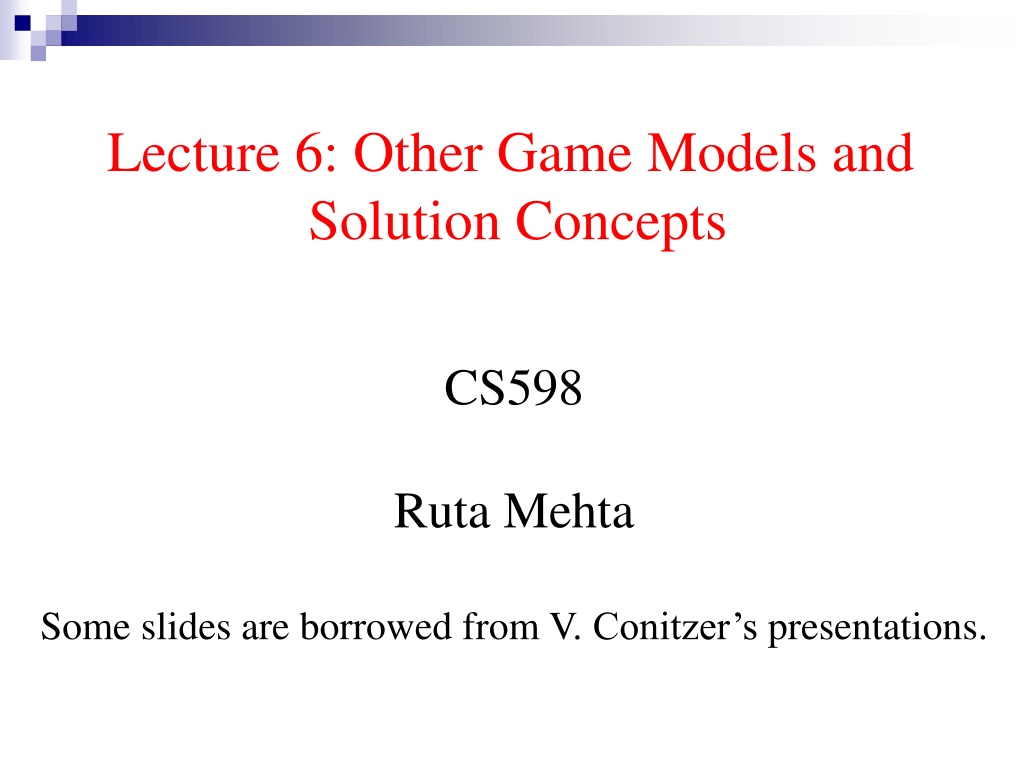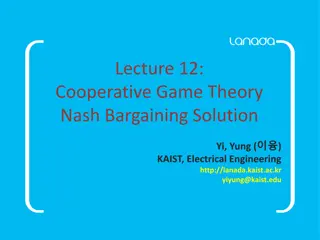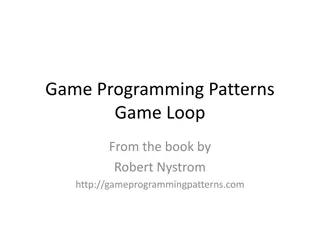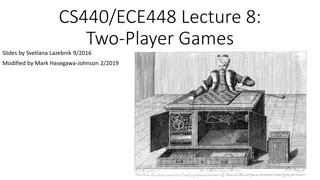Game Models and Solution Concepts Overview
Various game models and solution concepts including dominance, correlated equilibria, Stackelberg equilibria, and more. Delve into prisoners' dilemma, dominance by mixed strategies, checking for dominance, and iterated dominance in game theory.
Download Presentation

Please find below an Image/Link to download the presentation.
The content on the website is provided AS IS for your information and personal use only. It may not be sold, licensed, or shared on other websites without obtaining consent from the author.If you encounter any issues during the download, it is possible that the publisher has removed the file from their server.
You are allowed to download the files provided on this website for personal or commercial use, subject to the condition that they are used lawfully. All files are the property of their respective owners.
The content on the website is provided AS IS for your information and personal use only. It may not be sold, licensed, or shared on other websites without obtaining consent from the author.
E N D
Presentation Transcript
Lecture 6: Other Game Models and Solution Concepts CS598 Ruta Mehta Some slides are borrowed from V. Conitzer s presentations.
So far Normal-form games Multiple rational players, single shot, simultaneous move Nash equilibrium Existence Computation in two-player games.
Today: Dominance and Iterated Elimination Solution concepts Correlated equilibria Coarse-correlated equilibria Stackelberg equilibria Other Games Extensive-form Games Bayesian Games Poly-matrix Games
Dominance if Player i s strategy ?? strictly dominates ?? for all ? ?, ??(?? ,? ?) > ??(?? ?? weakly dominates ?? if for all ? ?, ??(?? ,? ?) ??(?? ,? ?); and for some ? ?, ??(?? ,? ?) > ??(?? ,? ?) ,? ?) -i = the player(s) other than i L M R 0, 0 1, -1 1, -1 -1, 1 0, 0 -1, 1 -1, 1 1, -1 0, 0 U strict dominance G weak dominance B
Prisoners Dilemma Pair of criminals has been caught They have two choices: {confess, don t confess} Attorney offers them a deal: If both confess to the major crime, they each get a 1 year reduction If only one confesses, that one gets 3 years reduction confess don t confess -2, -2 -3, 0 0, -3 -1, -1 confess don t confess
Dominance by Mixed strategies Example of dominance by a mixed strategy: 3, 1 0, 0 0, 0 3, 2 1, 0 1, 1 1/2 1/2
Bob n choices Alice m choices ?? ? ?? ?
Checking for dominance by mixed strategies in two-player games Linear feasibility problem to check if ? is weakly dominated by a mixed strategy ?: ?, ?????? ?? ? ???= 1 LP for checking whether strategy ? of Alice is strictly dominated by a mixed strategy ?: maximize such that: ? , ?????? ?? ?+ ? ???= 1 Holds for n-player games too!
Iterated dominance Iterated dominance: remove (strictly/weakly) dominated strategy, repeat. L M R 0, 0 1, -1 1, -1 U L R -1, 1 0, 0 -1, 1 G 0, 0 1, -1 -1, 1 0, 0 U B -1, 1 1, -1 0, 0 B
Iterated dominance: path (in)dependence Iterated weak dominance is path-dependent: sequence of eliminations may determine which solution we get (if any) (whether or not dominance by mixed strategies allowed) 0, 1 1, 0 0, 0 0, 0 1, 0 0, 1 0, 1 1, 0 0, 0 0, 0 1, 0 0, 1 0, 1 1, 0 0, 0 0, 0 1, 0 0, 1 Iterated strict dominance is path-independent: elimination process will always terminate at the same point (whether or not dominance by mixed strategies allowed)
Computational questions for n-player games. 1. Can a given strategy be eliminated using iterated dominance? 2. Is there some path of elimination by iterated dominance such that only one strategy per player remains? For strict dominance both can be solved in polynomial time due to path-independence Check if any strategy is dominated, remove it, repeat For weak dominance, both questions are NP-hard (even when all utilities are 0 or 1), with or without dominance by mixed strategies [Conitzer, Sandholm 05] Weaker version proved by [Gilboa, Kalai, Zemel 93]
?1 ?? ?? ?1 ?? ?? ?1 ?? ?? ?1 ?? ?? A B ???? ? ???, ? NE: ???? ???? , ? No one plays dominated strategies. Why this? What if they can discuss beforehand?
Players: {Alice, Bob} Two options: {Football, Shopping} 2 3 1 3 F S At Mixed NE both get 2/3 < 1 F 1 2 0 0 1 3 0.5 S 0 0 2 1 2 3 0.5 Instead they agree on (F, S), (S, F) Payoffs are (1.5, 1.5) Fair! Needs a common coin toss!
Correlated Equilibrium (CE) (Aumann 74) Mediator declares a joint distribution ? over S= ??? Tosses a coin, chooses ?~?. Suggests s? to player ? in private ? is at equilibrium if each player wants to follow the suggestion when others do. ,?(??, .), ?? ?1 ????,?(??, .) ???? ? ? ? ?? ??,? ???(??,? ?)Linear in P variables!
CE for 2-Player Case ?11 ??1 ?1? ??? Mediator declares a joint distribution ? = Tosses a coin, chooses ?,? ~?. Suggests ? to Alice, ? to Bob, in private. ? is at equilibrium if each player wants to follow the suggestion, when the other do too. Given Alice is suggested ?, she knows Bob is suggested ?~?(?, .) ????(?, .) ?? ???, . ? ?1 ?(. ,?)??? ?. ,???? ? ?2
Players: {Alice, Bob} Two options: {Football, Shopping} F S F 1 2 0 0 0.5 S 0 0 2 1 0.5 Instead they agree on (F, S), (S, F) Payoffs are (1.5, 1.5) CE! Fair!
Rock-Paper-Scissors (Aumann) Prisoner s Dilemma C NC R P S -2, -2 0, -3 C 0, 0 0, 1 1, 0 R 0 1 0 1/6 1/6 -3, 0 -1, -1 NC 1, 0 0, 0 0, 1 P 0 0 0 1/6 1/6 0, 1 1, 0 0, 0 NC is dominated S 0 1/6 1/6 When Alice is suggested R Bob must be following ?(?,.)= (0,1/6,1/6) Following the suggestion gives her 1/6 While P gives 0, and S gives 1/6.
Computation: Linear Feasibility Problem ? N-player game: Find distribution P over ? = ?=1 s.t. ????,?(??, .) ???? ? ??(?) = 1 ? ? ? ???(??,? ?)? ??,? ?Linear in P variables! ?? ,???, . , ??,?? ?? Two-player Game (A, B): ??????? ??? ???? ?,? ?1 ??????? ???? ??? ?,? ?2 ?????= 1
Computation: Linear Feasibility Problem ? N-player game: Find distribution P over ? = ?=1 s.t. ????,?(?,.) ???? ? ??(?) = 1 ? ? ? ???(??,? ?)? ??,? ?Linear in P variables! ?? ,???,. , ??,?? ?? Can optimize convex function as well!
Coarse- Correlated Equilibrium After mediator declares P, each player opts in or out. Mediator tosses a coin, and chooses s ~ P. If player ? opted in, then suggests her ?? in private, and she has to obey. If she opted out, then she knows nothing about s, and plays a fixed strategy ? ?? At equilibrium, each player wants to opt in, if others are. ??? ???,? ?, ? ?? Where ? ? is joint distribution of all players except i.
Importance of (Coarse) CE Natural dynamics quickly arrive at approximation of such equilibria. No-regret, MWU Poly-time computable in the size of the game. Can optimize a convex function too.
Show the following CCE CE NE PNE
Extensive-form Game Players move one after another Chess, Poker, etc. Tree representation. Firm 2 Strategy of a player: What to play at each of its node. out in Firm 1 2,0 accommodate fight I O -1, 1 2, 0 -1,1 1,1 F 1, 1 2, 0 A Entry game
A poker-like game Both players put 1 chip in the pot Player 1 gets a card (King is a winning card, Jack a losing card) Player 1 decides to raise (add one to the pot) or check Player 2 decides to call (match) or fold (P1 wins) If player 2 called, player 1 s card determines pot winner nature 1 gets King 1 gets Jack player 1 player 1 raise check raise check player 2 player 2 call fold call fold call fold call fold 2 1 1 1 -2 1 -1 1
Poker-like game in normal form nature 1 gets King 1 gets Jack cc cf fc ff player 1 player 1 0, 0 .5, -.5 -.5, .5 0, 0 0, 0 1, -1 0, 0 1, -1 0, 0 1, -1 1, -1 1, -1 1, -1 rr raise check raise check rc 1.5, -1.5 -.5, .5 1, -1 player 2 player 2 cr call fold call fold call fold call fold cc 2 1 1 1 -2 1 -1 1 Can be exponentially big!
Sub-Game Perfect Equilibrium Every sub-tree is at equilibrium Computation when perfect information (no nature/chance move): Backward induction Firm 2 out in Firm 1 2,0 accommodate fight Firm 2 out in 1,1 -1,1 1,1accommodate 2,0 Entry game
Sub-Game Perfect Equilibrium Every sub-tree is at equilibrium Computation when perfect information (no nature/chance move): Backward induction Firm 2 out in Firm 1 (accommodate, in) 2,0 accommodate fight Firm 2 out in 1,1 -1,1 1,1accommodate 2,0 Entry game
Corr. Eq. in Extensive form Game How to define? CE in its normal-form representation. Is it computable? Recall: exponential blow up in size. Can there be other notions? See Extensive-Form Correlated Equilibrium: Definition and Computational Complexity by von Stengel and Forges, 2008.
Commitment (Stackelberg strategies)
Commitment 1, 1 3, 0 0, 0 2, 1 Unique Nash equilibrium (iterated strict dominance solution) von Stackelberg Suppose the game is played as follows: Player 1 commits to playing one of the rows, Player 2 observes the commitment and then chooses a column Optimal strategy for player 1: commit to Down
Commitment: an extensive-form game For the case of committing to a pure strategy: Player 1 Up Down Player 2 Player 2 Left Right Left Right 1, 1 3, 0 0, 0 2, 1
Commitment to mixed strategies 0 1 1, 1 0, 0 3, 0 2, 1 .49 .51 Also called a Stackelberg (mixed) strategy
Commitment: an extensive-form game for the case of committing to a mixed strategy: Player 1 (1,0) (=Up) (0,1) (=Down) (.5,.5) Player 2 Left Right Left Right Left Right 2, 1 1, 1 3, 0 .5, .5 2.5, .5 0, 0 Economist: Just an extensive-form game, nothing new here Computer scientist: Infinite-size game! Representation matters
Computing the optimal mixed strategy to commit to [Conitzer & Sandholm EC 06] Alice is a leader. Separate LP for every column j* ?2: maximize ?????? subject to ?, ???? ???? ???= 1 Pick the one that gives max utility. Row utility Column optimality distributional constraint
On the game we saw before 1, 1 3, 0 0, 0 2, 1 x y maximize 1x + 0y maximize 3x + 2y subject to subject to 1x + 0y 0x + 1y 0x + 1y 1x + 0y x + y = 1 x + y = 1 x 0, y 0 x 0, y 0
Generalizing beyond zero-sum games Minimax, Nash, Stackelberg all agree in zero-sum games 0, 0 -1, 1 -1, 1 0, 0 zero-sum games minimax strategies zero-sum games general-sum games Nash equilibrium zero-sum games general-sum games Stackelberg mixed strategies
Other nice properties of commitment to mixed strategies 0, 0 -1, 1 No equilibrium selection problem 1, -1 -5, -5 Leader s payoff at least as good as any Nash eq. or even correlated eq. (von Stengel & Zamir [GEB 10])
Previous Lecture Dominance and Iterated Elimination Solution concepts Correlated equilibria Coarse-correlated equilibria Stackelberg equilibria Other Games Extensive-form Games Bayesian Games Succinct multi-player games: Poly-matrix
Bayesian Games So far in Games, - Complete information (each player has perfect information regarding the element of the game). Bayesian Game - A game with incomplete information - Each player has initial private information, type. - Bayesian equilibrium: solution of the Bayesian game
Bayesian game Utility of a player depends on her type and the actions taken in the game i is player i s type, drawn according to some distribution from set of types i Each player knows/learns its own type, but only distribution of others (before choosing action) Pure strategy ??: ? ??(where Si is i s set of actions) In general players can also receive signals about other players utilities; we will not go into this L R L R 4 6 U 4 6 U column player type 1 (prob. 0.5) row player type 1 (prob. 0.5) 4 6 D 2 4 D L R L R 2 2 U 2 4 U column player type 2 (prob. 0.5) row player type 2 (prob. 0.5) 4 2 D 4 2 D
Car Selling Game A seller wants to sell a car A buyer has private value v for the car w.p. P(v) Sellers knows P, but not v Seller sets a price p , and buyer decides to buy or not buy. If sell happens then the seller is happy, and buyer gets v-p. ?1=All possible prices, 1={1} ?2={buy, not buy}, 2=All possible v ?11,(?,buy) = 1,U11,(p,not buy) = 0 ?2(?,(?,buy))=? ?, ?2?,(?,not buy) = 0
Converting Bayesian games to normal form L R row player type 1 (prob. 0.5) L R 4 6 U 4 6 U column player type 1 (prob. 0.5) 4 6 D 2 4 D L R L R 2 2 U 2 4 U column player type 2 (prob. 0.5) row player type 2 (prob. 0.5) 4 2 D 4 2 D type 1: L type 2: L type 1: L type 2: R type 1: R type 2: L type 1: R type 2: R type 1: U type 2: U 3, 3 4, 3 4, 4 5, 4 exponential blowup in size 4, 3.5 4, 3 4, 4.5 4, 4 type 1: U type 2: D 2, 3.5 3, 3 3, 4.5 4, 4 type 1: D type 2: U 3, 4 3, 3 3, 5 3, 4 type 1: D type 2: D
Bayes-Nash equilibrium A profile of strategies is a Bayes-Nash equilibrium if it is a Nash equilibrium for the normal form of the game Minor caveat: each type should have >0 probability Alternative definition: Mixed strategy of player i, ??: ? ?? for every i, for every type i, for every alternative action si, we must have: -iP( -i) ui( i, i( i), -i( -i)) -iP( -i) ui( i, si, -i( -i)) ? ??(??)
Again what about corr. eq. in Bayesian games? Notion of signaling. Look up the literature.
Multi-player games Some slides from C. Papadimitriou s presentation.
Many player Games With games we are supposed to model markets and the Internet These have many players To describe a game with n players and s strategies per player you need nsn numbers Khachiyan lecture, March 2 06
Recall: Corr. Eq. in n-player game Linear programming! n players, s strategies each ns2 inequalites sn variables! Nice for 2 or 3 players But many players? Khachiyan lecture, March 2 06
Many players (cont.) These important games cannot require astronomically long descriptions if your problem is important, then its input cannot be astronomically long Conclusion: Many interesting games are 1. multi-player 2. succinctly representable Khachiyan lecture, March 2 06
e.g., Graphical Games [Kearns et al. 2002] Players are vertices of a graph, each player is affected only by his/her neighbors If degrees are bounded by d, nsd numbers suffice to describe the game Also: polymatrix, congestion, anonymous, hypergraphical, Khachiyan lecture, March 2 06
Theorem: A correlated equilibrium in a succinct game can be found in polynomial time provided the utility expectation over mixed strategies can be computed in polynomial time. [Papadimitriou & Roughgarden 08, Jiang & Leyton-Brown 10] Khachiyan lecture, March 2 06

























